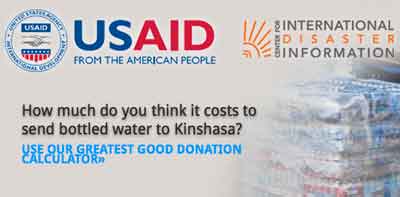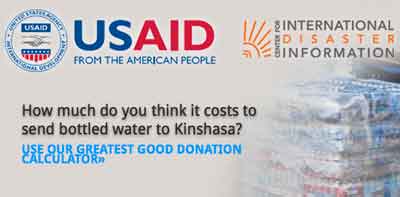 KINGSTON, R.I., May 16, 2013 – University of Rhode Island business and computer engineering students have joined forces to create an online calculator for the USAID Center for International Disaster Information (CIDI) that clearly demonstrates the inefficiency of donating goods after disaster strikes and makes a case for giving money instead.
KINGSTON, R.I., May 16, 2013 – University of Rhode Island business and computer engineering students have joined forces to create an online calculator for the USAID Center for International Disaster Information (CIDI) that clearly demonstrates the inefficiency of donating goods after disaster strikes and makes a case for giving money instead.
Relief workers have known for a long time that donated items, such as bottled water and clothing, are astronomically expensive to ship overseas and cause slow downs at key areas near the emergency. For example, after the earthquake in Haiti, donated goods flowed in from around the world from people with the best intentions but the supplies filled the country’s only airport and clogged supply lines to those in need.
“Time is the essence when there is a disaster,” said Assistant Business Professor Koray Özpolat, pointing out that cash donations could be flexibly used to buy whatever is urgently needed in the disaster area.
That is where the student-created Greatest Good Donation Calculator comes in – www.cidi.org/how-disaster-relief-works/greatest-good-donation-calculator. Simply enter the item you want to ship, where you’re shipping it from, and the destination. And the calculator will tell you the cost of your donation. For example, shipping a pair of jeans from Washington, D.C. to Kabul, Afghanistan will cost $202.05. For that much money, a local relief organization could purchase 40,410 liters of drinking water.
By showing the logistical inefficiencies of donating and what could be purchased with a monetary donation, the calculator is a way to encourage people to give money in lieu of commodities.
“This great tool for donors illustrates the true cost of sending material donations to disaster sites, and demonstrates how monetary donations can help many more people hit hard by disasters. We are grateful to URI for this unique, interactive encouragement of smart compassion – providing the most effective assistance to those who need it most,” said CIDI Director Juanita Rilling.
Rilling proposed the idea of a humanitarian calculator to Özpolat last year after four students in his operations and supply chain management class won 2nd and 3rd place in CIDI’s 2012 Public Service Announcements for Disaster Relief Contest.
Özpolat knew more than logistical data was required for this unique calculator and reached out to Associate Professor Resit Sendag from URI’s Electrical, Computer, and Biomedical Engineering Department. The parameters of the project were determined and it was sponsored by URI College of Business Administration Dean Mark Higgins. Özpolat and Sendag invited business students Richard Kalhofer and Christopher O’Keefe to work on the logistics and computer engineering student Ben Ricci to figure out the web design, code, and calculations application.
Ricci, 22, of Portsmouth, R.I., who will graduate from URI on May 19, was already working a 40-hour-a-week internship when Özpolat and Sendag approached him last summer. Despite limited free time, he took on the project and learned the database design and web design aspects quickly and wrote code for the project. While Kalhofer and O’Keefe collected shipping and storage data, Ricci worked with CIDI’s IT professionals, who praised him for writing clean code that was easy to read and edit.
“I learned a lot of technical stuff and worked with industry and business people,” said Ricci, who is looking at career opportunities and has received several job offers. “I learned a lot about time management.”
Sendag agreed, “It worked out very well. Ben learned everything he needed to and put it together.”
Özpolat believes the project, which has national reach, was beneficial for three primary reasons: as a social responsibility undertaking for URI that will help Americans practice smart compassion; as an interdisciplinary collaboration for business and engineering students and faculty; and as an experiential, real world learning opportunity for students.

